
 January 4, 2020
January 4, 2020
If you think—and some of you I know do—that I’ve got a big head, you should see some of the statues we’ve been looking at today.
They’re from the Olmec civilization, circa 1200-200 BC. You can find them in lots of places; we first did a year ago, at the National Archeological Museum in Mexico City. That’s really a great introduction to Mesoamerica because, as the nation’s major museum, it got first crack at most of the art (that didn’t wind up in Europe or the United States). There are, however, enough Mesoamerican artifacts to fill more than one museum.


For example, you can spend an afternoon in Villahermosa (literally, beautiful city), a town of some 700,000, the capital of the state of Tabasco (known in Mexico as the birthplace of President Amlo—not Tabasco sauce which is I recall a product of Louisiana imagination). Here, a very imaginative poet conceived of moving the Olmec ruins from inaccessible La Venta to an accessible park in the city which housed a natural history museum, an aquarium, a planetarium, a zoo, and a host of other institutions, which now includes an archeological park of some 40 Olmec statues, altars, and plinths set in the lush jungle.
The enormous heads draw speculation on the transport of tons of stone because the Mesoamericans did not have wheels. And yet…basalt and sandstone in particular, with ten foot heads were transported (my favorite guess was using whale grease), paving the way, so archeologists argue, for the later Mayans, the bas-reliefs giving rise to later steles, and some of the art patterns repeated for the next 12-1500 years by their successors (and adopted by THEIR successors, the Aztecs, and their successors, contemporary Mexicans).
 The Olmec area seems to have been in the Yucatán/Guatemala/Honduras jungles, and the artifacts in the park cover about 500 years, mostly from La Venta. I had to take pictures of Carolyn with the “Grandmother”, and myself with “The Walker,” but the most stunning items besides the big heads are the altars, usually with a man/bird/jaguar/crocodile half emerging
The Olmec area seems to have been in the Yucatán/Guatemala/Honduras jungles, and the artifacts in the park cover about 500 years, mostly from La Venta. I had to take pictures of Carolyn with the “Grandmother”, and myself with “The Walker,” but the most stunning items besides the big heads are the altars, usually with a man/bird/jaguar/crocodile half emerging from a cave (the underworld). The eagle carried the sun during the day (and is part of the Mexican flag), and the jaguar carried the sun through the netherworld at night.
from a cave (the underworld). The eagle carried the sun during the day (and is part of the Mexican flag), and the jaguar carried the sun through the netherworld at night.
From Villahermosa, our trek meant a short flight to Merida, capital of the Yucatan (and purportedly Mexico’s safest city) and then an hour and a half ride to Chichen Itza, where tomorrow we get the advanced course in all things Mayan.